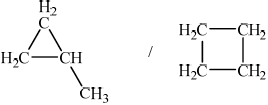Question
The periodic table is a useful tool in explaining trends of chemical behaviour.
(a) (i) Annotate and label the ground state orbital diagram of boron, using arrows to represent electrons.

(ii) Sketch the shapes of the occupied orbitals identified in part (a)(i).

(b) Explain the decrease in first ionization energy from Li to Cs, group 1.
(c) (i) State the electron domain geometry of the ammonia molecule.
(ii) Deduce the Lewis (electron dot) structure of ammonia and sketch its 3D molecular shape.

(iii) Explain, with reference to the forces between molecules, why ammonia has a higher boiling point than phosphine \((PH_3)\).
(d) (i) Ammonia is manufactured by the Haber process.
\(N_2(g)+3H_2(g)\rightleftharpoons 2NH_3 (g)\) \(\Delta H^{\theta}_t = -92.0\) KJ \(mol^{-1}\)
Outline what is meant by dynamic equilibrium.
(ii) Deduce the \(K_c\) expression for the reaction in part (d)(i).
(iii) Determine the entropy change. \( \Delta S^{\theta}\) for the forward reaction to four significant figures, using the data given.

(iv) Calculate the temperature, in K, below which this reaction becomes spontaneous.
Use section 1 of the data booklet. (If you were unable to obtain an answer for part (d)(iii) use -210.0J \(K^{-1} mol^{-1}\), but this is not the correct value.)
(v) The value of \(K_c\) for this reaction is \(6.84 × 10^{-5}\) at 500°C. Suggest, with a reason, how lowering the temperature affects the value of \(K_c\).
(vi) Calculate the standard Gibbs free energy change, \(ΔG^{\theta}\), in kJ \(mol^{-1}\), for this reaction. Use sections 1 and 2 of the data booklet.
(e) (i) The Haber process requires a catalyst. State how a catalyst functions.
(ii) Sketch a Maxwell–Boltzmann distribution curve showing the activation energies with and without a catalyst.

(iii) Suggest how the progress of the reaction could be monitored.
Answer/Explanation
Answer:
(a) (i) 
arrows AND identifies 2s AND 2p sub orbitals
(ii) 
(b) valence electron further from nucleus/«atomic» radius larger «down the group»
«electron» more shielded/ less attractive force/easier to remove
(c) (i) tetrahedral
(ii) 
(iii)
ammonia has intermolecular/IMF hydrogen bonds «phosphine does not»
phosphine «and ammonia» dipole-dipole/London dispersion forces/instantaneous
dipole attractions/Van der Waals forces
hydrogen bonds stronger
(d) (i) «in a closed system» the rate of the forward reaction equals the rate of the
reverse reaction.
(ii) \([NH_3]^2/([N_2][H_2]^3)\)
(iii) \(\Delta S^{\theta}=\Delta S^{\theta}_(products)-\Delta S^{\theta}_{reactants}\)
OR
\((2 \times 192.8\) << J \(mol^{-1} K^{-1}\)>> ) – (3 \(\times \)130.7 << J \(mol^{-1} K^{-1}\) >> + 191.6 << J \(mol^{-1} K^{-1}\) >>)
(d) (iv) 
(v) «reaction» exothermic AND Kc increases «as equilibrium moves right»
(vi) 
(e) (i) alternate pathway AND lowers activation energy/\(E_a\)
(ii) 
correct shape curve starting at the origin, without touching the x axis at high
energy.
(\(E_a\)) catalysed <(\(E_a\)) uncatalysed on x axis.
(e) (iii) change in AND
volume
OR
pressure
OR
temperature
OR
concentration of \(H_2\)/\(N_2\) /reactants/\(NH_3\) /product
Question
But-2-ene is a straight-chain alkene with formula \({{\text{C}}_{\text{4}}}{{\text{H}}_{\text{8}}}\). The molecule contains both \(\sigma \) and \(\pi \) bonds.
The polymerization of the alkenes is one of the most significant reactions of the twentieth century.
(i) Explain the formation of the \(\pi \) bond.
(ii) For each of the carbon atoms, C(1) and C(2), identify the type of hybridization shown.
C(1):
C(2):[3]
But-2-ene shows geometrical isomerism. Draw the structural formula and state the name of the other geometrical isomer.[2]
Identify the structural formula of an isomer of but-2-ene which does not decolourize bromine water, Br2(aq).[1]
(i) Outline two reasons why the polymers of the alkenes are of economic importance.
(ii) State the type of polymerization reaction shown by the alkene in part (a).
(iii) Deduce the structure of the resulting polymer showing three repeating units.
(iv) Explain why monomers are often gases or volatile liquids, but polymers are solids.[6]
Answer/Explanation
Markscheme
(i) (bond formed by) sideways overlap;
(of) p orbitals;
Marks awarded either from sketch or from explanation.
(ii) C(l) is sp3 and C(2) is sp2;
 ;
;
cis but-2-ene/Z-but-2-ene;
 ;
;
(i) synthesis of materials not naturally available/plastics;
chemically unreactive materials produced;
wide range of uses/physical properties / versatile;
cheap;
large industry;
uses a limited natural resource;
Award [2] for any two.
(ii) addition;
(iii)  ;
;
Must show continuation bonds.
Ignore bracket around the 6 carbons.
Must have 6 carbons joined to each other along chain.
(iv) monomers are smaller molecules / have smaller surface area than polymers;
Accept monomers have lower molecular mass.
with weaker intermolecular/Van der Waals’/London/dispersion forces;
Accept opposite argument for polymers.
Examiners report
This question was generally well answered and many high scores were seen. Most candidates were able to explain the formation of \(\pi \) bonds in (a) and identify the type of hybridization present.
Many candidates drew structures which were not geometric isomers in (b) with but-1-ene a common incorrect answer.
In (c) only the best candidates were able to identify a cycloalkane as a saturated isomer and it was fairly common to find structures that included double bonds despite the guidance in the question.
The economic importance of addition polymers was well known in (d) with most candidates stating that they were plastics with versatile properties and low cost.
Addition polymerisation was well recalled but a large number of candidates made mistakes with the structure of the polymer. Continuation bonds, for example, were often missing from the ends. Many understood in terms of molecular size, why polymers have higher boiling points than monomers but not all correctly attributed it to the stronger van der Waals forces between the molecules.